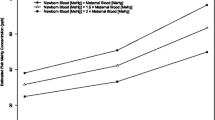Abstract
An analysis was performed of a large epidemiological study conducted in New Zealand to evaluate the neurological effects of prenatal methylmercury (MeHg) exposure in children. In the epidemiological study, 6-year-old children, whose mothers had been exposed to MeHg through the consumption of fish, were administered performance tests to ascertain academic attainment, language development, fine and gross motor coordination, intelligence and social adjustment. These responses were correlated with estimates of prenatal exposure based on average maternal hair concentrations during pregnancy. The Benchmark Dose analysis performed in the current study suggests that the NOAEL for the most sensitive indicator of developmental effects (Test of Language Development — grammar understanding) occurs at approximately 17 ppm Hg in maternal hair. A physiologically based pharmacokinetic (PBPK) model for MeHg was developed which coherently described MeHg pharmacokinetics in the adult rat, monkey and man, and predicts fetal levels of MeHg fromin utero exposure. The model includes a description of enterohepatic recirculation of MeHg, conversion to inorganic mercury in tissues and intestinal flora, slowly reversible incorporation of mercury in tissues, and excretion of both organic and inorganic mercury into urine, feces, and hair. Analysis with the PBPK model indicates that fetal brain concentrations of MeHg at the NOAEL are on the order of 50 ppb (μg/L), and are associated with maternal dietary intakes of MeHg ranging from 0.8 to 2.5μg/kg/day. Since this analysis is based on the most sensitive endpoint in a large, general human population, no uncertainty factor should be necessary using the standard USEPA approach for setting RfDs. Therefore, the RfD suggested by this analysis would be a factor of from 3 to 8 above the current USEPA RfD of 0.3μg/kg/day.
Similar content being viewed by others
References
Aschner, M. and Aschner, J.: 1990,Neurosci. & Biobehav. Rev. 14, 169–176.
Aschner, M. and Clarkson, T.: 1988.Teratology 38, 145–155.
Ballatori, N. and Clarkson, T.: 1983,Am. J. Physiol. 244, G435-G441.
Ballatori, N. and Clarkson, T.: 1985,Am J Physiol 248, G238-G245.
Birke, G., Johnels, G., Plantin, L-O., Sjostrand, B., Skerfving, S., Westermark, T.: 1972,Arch. Environ. Health 25:77.
Bourne, G. H.: 1975.The Rhesus Monkey. Vol 1. Academic Press, New York.
Burbacher, T., Rodier, P., Weiss, B.: 1990,Neurotoxicol. Teratol. 12, 191–202.
Burbacher, T. M., Mohamed, M. K., Mottett, N. K.: 1988,Reprod. Toxicol. 1, 267–278.
Choi, B.: 1989,Prog. Neurobiol. 32, 447–470.
Clarkson, T.: 1990,Environ. Toxicol. Chem. 9, 957–961.
Clarkson, T., Amin-Zaki, L., Tikriti, S.: 1976,Fed. Proc. 35, 2395–2399.
Cox, C., Clarkson, T., Marsh, D., Amin-Zaki, L., Tikriti, S., Myers, G..: 1989,Environ. Res. 49, 318–332.
Crump, K.S.: 1984,Fund. Appl. Toxicol. 4, 854–871.
Crump, K.S.: 1994,Risk Anal. (in press).
Evans, H., Garman, R.H., Weiss, B.: 1977,Toxicol. and Appl. Pharmacol. 41, 15–33.
Farris, F., Dedrick, R., Allen, P., Smith, J.: 1993,Toxicol. and Appl. Pharmacol. 119, 74–90.
Faustman, E., Allen, B., Kimmel, C., Kavlock, R.: 1994,Fund. Appl. Toxicol. (in press).
Forsyth, R.P., Nies, A.S., Wyler, F., Neutze, J., Melmon, K.L.: 1968,J. Appl. Physiol. 25, 736–741.
Gaylor, D.W. and Slikker, W.: 1990,Neuro Toxicology 11, 211–218.
Gerlowski, L.E. and Jain, R.K.: 1983,J. Pharm. Sci. 72, 1103–1126.
Hytten, F.E. and Leitch, I.: 1971,The Physiology of Human Pregnancy, Blackwell, 599 pp.
International Commission on Radiological Protection: 1975,Report of the Task Group on Reference Man — ICRP Publication 23, 480 pp.
Kawasaki, Y., Ikeda Y., Yamamoto T., Ikeda K.: 1986,J. Food Hyg. Soc. Jpn. 27, 528–552.
Kimmel, C. and Gaylor, D.: 1988,Risk Anal. 8, 15–21.
Kjelstrom, T., Kennedy, P., Wallis, S., Stewart, A., Fribert, L., Lind, B., Wutherspoon, T., Mantell, C.: 1989, National Swedish Environmental Protection Board Report 3642.
Rice, D.: 1989,J. Toxicol. Environ. Health 27, 189–198.
Rice, D., Krewski, D., Collins, B., Willes, R.: 1989,Fund. Appl. Toxicol. 12, 23–33.
Sherlock, J., Hislop, J., Newton, D., Topping, G., Whittle, K.: 1984,Human Toxicol. 3, 117–131.
Stern, A.: 1993,Risk Anal. 13, 355–364.
U.S. Environmental Protection Agency (EPA). 1990. Interim Methods for Development of Inhalation Reference Concentrations. EPA/600/8-90/066A.
Author information
Authors and Affiliations
Rights and permissions
About this article
Cite this article
Gearhart, J.M., Clewell, H.J., Crump, K.S. et al. Pharmacokinetic dose estimates of mercury in children and dose-response curves of performance tests in a large epidemiological study. Water Air Soil Pollut 80, 49–58 (1995). https://doi.org/10.1007/BF01189652
Issue Date:
DOI: https://doi.org/10.1007/BF01189652




